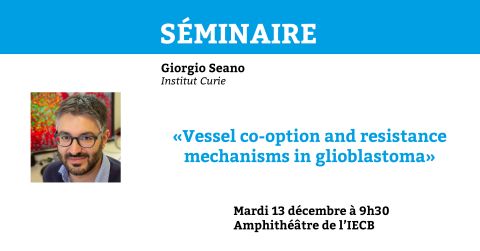Vessel co-option and resistance mechanisms in glioblastoma
Glioblastoma (GBM) is one of the deadliest types of human cancer. Despite a very aggressive treatment regime – including resection of the tumor, radiation and chemotherapy – its recurrence rate is more than 90%. Recurrence is mostly caused by of chemoradiation the regrowth of highly invasive and resistant cells spreading from the tumor bulk, which are not removed by resection. To develop an effective therapeutic approach, we need to better understand the underlying molecular and cellular mechanisms resistance and tumor spreading in GBM.
Using bulk and sc-RNA-Seq, in vitro and in vivo real-time imaging, organotypic cultures and functional assays, we demonstrated that a dormant and invasive GBM cell functional state, even if already partly present in tumor cells, is further stimulated by both chemoradiation and perivascular niche. A better cell survival, G2M arrest and upregulation of senescence pathways make this YAP1-driven GBM state more resistant to therapy. Notably, these resistant GBM cells are highly vessel co-opting allowing homing to the perivascular niche, that in turn increases reprogramming towards this cell state. These findings demonstrate how perivascular niche and GBM cell plasticity jointly drive a vicious loop leading to resistance to therapy during GBM recurrence.
---------------------------------------------------------------------------------------------------------------------------------------------------
Dr. Seano is the Head of the Tumor Microenvironment Lab at Institut Curie-Orsay. His scientific interests are tumor vasculature, vessel co-option, cell migration and radioresistance. Among others, he published on Science, Cancer Cell, Nat Cell Biol, Nat Biom Eng, Blood, PNAS, JNCI and Cancer Res.
During his training in Italy (a) he investigated tumor angiogenesis and integrins, (b) provided the first evidence of a new subcellular structure – the endothelial podosome rosette – that controls sprouting angiogenesis and (c) developed the first ex vivo human angiogenesis assay. Next he joined the laboratory of Dr. Jain at Harvard Medical School (Boston). There he investigated (a) physical forces from brain tumors and their effects on neuro-vascular functions and (b) vessel co-option in glioblastoma.
In 2018 he set up his own lab focused on brain tumors microenvironment and resistance mechanisms. Among other funding, Dr. Seano’s lab is currently funded by ERC Starting Grant, INCa PLBIO, INCa PAIR and Canceropole.


